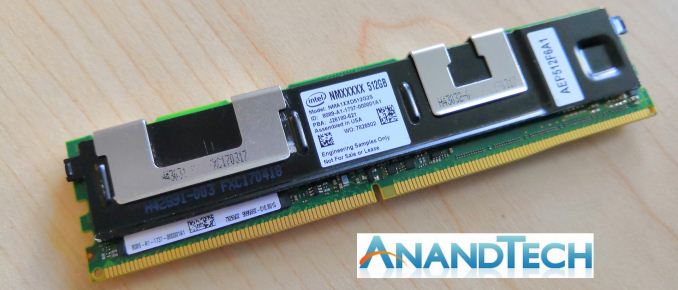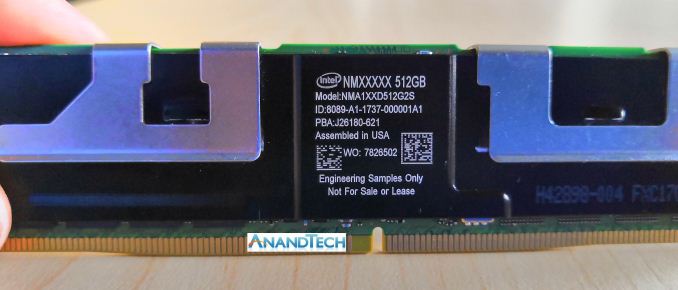Intel Launches Optane DIMMs Up To 512GB: Apache Pass Is Here!
by Ian Cutress & Billy Tallis on May 30, 2018 2:15 PM EST
Intel today announced the availability of their long-awaited Optane DIMMs, bringing 3D XPoint memory onto the DDR4 memory bus. The modules that have been known under the Apache Pass codename will be branded as Optane DC Persistent Memory, to contrast with Optane DC SSDs, and not to be confused with the consumer-oriented Optane Memory caching SSDs.
The new Optane DC Persistent Memory modules will be initially available in three capacities: 128GB, 256GB and 512GB per module. This implies that they are probably still based on the same 128Gb 3D XPoint memory dies used in all other Optane products so far. The modules are pin-compatible with standard DDR4 DIMMs and will be supported by the next generation of Intel's Xeon server platforms.
The Optane DC Persistent Memory modules Intel is currently showing off have heatspreaders covering the interesting bits, but they appear to feature ten packages of 3D XPoint memory. This suggests that the 512GB module features a raw capacity of 640GB and that Optane DC Persistent Memory DIMMs have twice the error correction overhead of ECC DRAM modules.
The Optane DC Persistent Memory modules are currently sampling and will be shipping for revenue later this year, but only to select customers. Broad availability is planned for 2019. In a similar strategy to how Intel brought Optane SSDs to market, Intel will be offering remote access to systems equipped with Optane DC Persistent Memory so that developers can prepare their software to make full use of the new memory. Intel is currently taking applications for access to this program. The preview systems will feature 192GB of DRAM and 1TB of Optane Persistent Memory, plus SATA and NVMe SSDs. The preview program will run from June through August. Participants will be required to keep their findings secret until Intel gives permission for publication.
Intel is not officially disclosing whether it will be possible to mix and match DRAM and Optane Persistent Memory on the same memory controller channel, but the 192GB DRAM capacity for the development preview systems indicates that they are equipped with a 16GB DRAM DIMM on every memory channel. Also not disclosed in today's briefing: power consumption, clock speeds, specific endurance ratings, and whether Optane DC Persistent Memory will be supported across the Xeon product line or only on certain SKUs. Intel did vaguely promise that Optane DIMMs will be operational for the normal lifetime of a DIMM, but we don't know what assumptions Intel is making about workload.
Intel has been laying the groundwork for application-level persistent memory support for years through their open-source Persistent Memory Development Kit (PMDK) project, known until recently as NVM Library. This project implements the SNIA NVM Programming Model, an industry standard for the abstract interface between applications and operating systems that provide access to persistent memory. The PMDK project currently includes libraries to support several usage models, such as a transactional object store or log storage. These libraries build on top of existing DAX capabilities in Windows and Linux for direct memory-mapped access to files residing on persistent memory devices.
Optane SSD Endurance Boost
The existing enterprise Optane SSD DC P4800X initially launched with a write endurance rating of 30 drive writes per day (DWPD) for three years, and when it hit widespread availability Intel extended that to 30 DWPD for five years. Intel is now preparing to introduce new Optane SSDs with a 60 DWPD rating, still based on first-generation 3D XPoint memory. Another endurance rating increase isn't too surprising: Intel has been accumulating real-world reliability information about their 3D XPoint memory and they have been under some pressure from competition like Samsung's Z-NAND that also offers 30 DWPD with a more conventional flash-based memory.
















73 Comments
View All Comments
rahvin - Wednesday, May 30, 2018 - link
0.1ms to 10ms is 100x, or am I just not using that newfangled math where 0.1ms x 100 = 10ms. Now admittedly the range he gave was 10x to 100x which is a little silly in it's extreme scale.Old_Fogie_Late_Bloomer - Wednesday, May 30, 2018 - link
No newfangled math involved, you and he are just using regular math wrong.6/0.1 = 60, 10/0.99 = 10.1 (but let's stop beating around the bush and call it 10). Unless he has more data than he's presented here, "100x" simply isn't justifiable.
I'm not arguing that Optane isn't overly hyped. I'm just saying if your best hypothetical case is 0.1 and your worst real case is 10, then 100x is not an honest number.
Lolimaster - Thursday, May 31, 2018 - link
Optane latency was supposed to be in the sub microsecond range hence the 0.1+ microseconds.Lolimaster - Wednesday, May 30, 2018 - link
My idea is that the regular DRAM is working as a cache for the most changing data keeping optane for workset data and read operations.ಬುಲ್ವಿಂಕಲ್ ಜೆ ಮೂಸ್ - Wednesday, May 30, 2018 - link
I'd like to test the ease of keeping persistent malware in that workset data for these new dimmsCheapSushi - Wednesday, May 30, 2018 - link
That's exactly what is going on. In fact a 3D Xpoint DIMM is PAIRED with a RAM DIMM. Idiots on here keep thinking it's replacing the DRAM. It's NOT.alpha754293 - Wednesday, May 30, 2018 - link
Sorry for coming to the party late but what is Persistent Memory? And how is that different than Optane?I'm not sure if I really understand it.
Is it just "RAM"? NV RAM? ???
If someone can just walk back about 100 steps, or point to a reference, that would be greatly appreciated.
Thank you.
Billy Tallis - Wednesday, May 30, 2018 - link
Persistent Memory is an umbrella term for memory technologies that can be accessed like RAM, but don't lose their contents when unplugged the way DRAM and SRAM do. NAND flash memory is non-volatile, but its block/page oriented structure makes it impractical to directly access in a RAM-like fashion, and its performance is nowhere close to DRAM in any respect. 3D XPoint is a persistent memory technology from Intel, and Optane is their brand for products using 3D XPoint memory. Optane DC Persistent Memory is the brand for Optane products that go in DDR4 memory module slots, as opposed to Optane SSDs that use the NVMe block storage interface and behave more like NAND flash based SSDs.faiakes - Wednesday, May 30, 2018 - link
Would it make sense to have a OS bootable 512Gb stick?CaptCalamity - Wednesday, May 30, 2018 - link
Honestly, noticeable differences in "normal" use on a home pc diminish greatly beyond a sata ssd. M.2 drives are nice and speedy but your not going to see the benefit of moving to them from an ssd that you would moving from a mechanical hard drive to an ssd. With this, unless you are in some very specific niche workloads, you won't see any benefit worth the cost.That being said, it will eventually be in one of my systems.